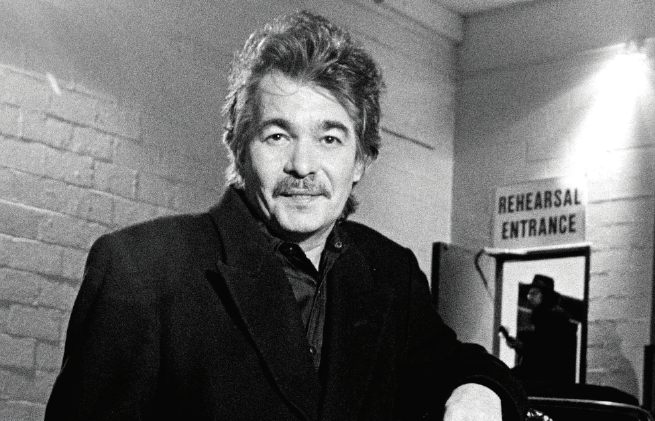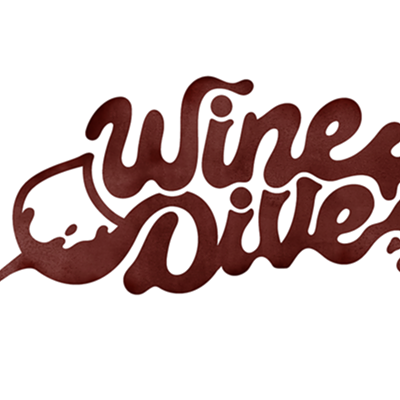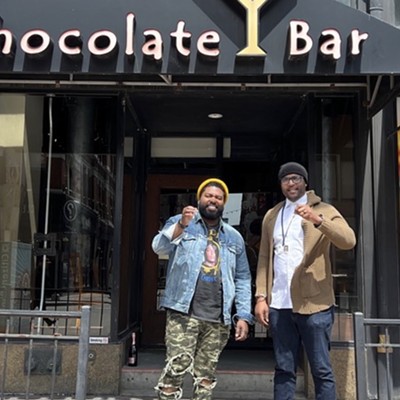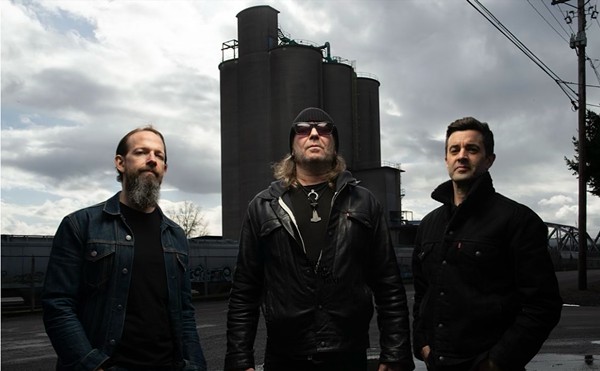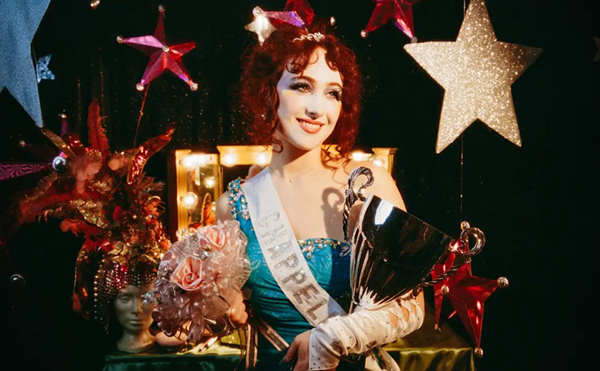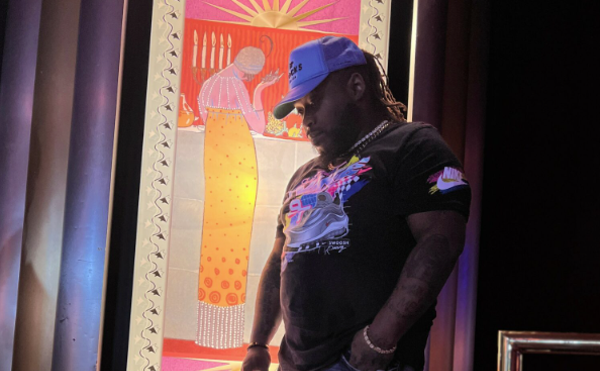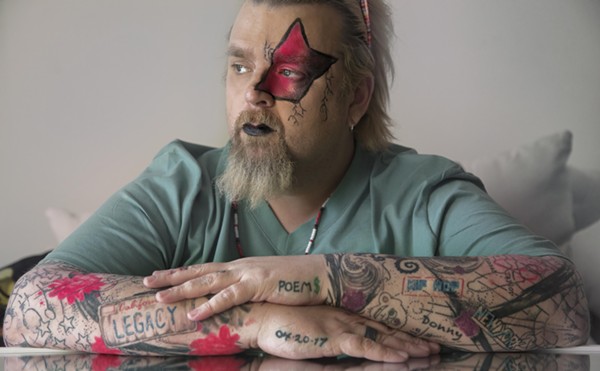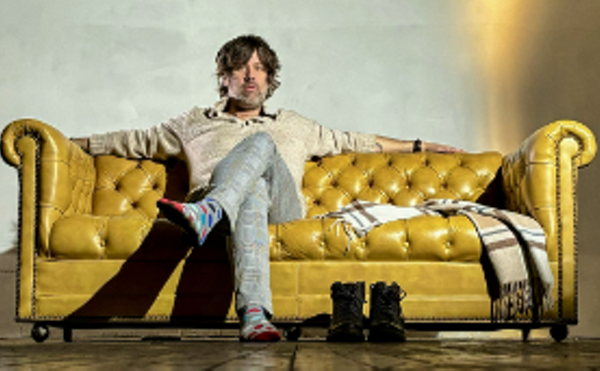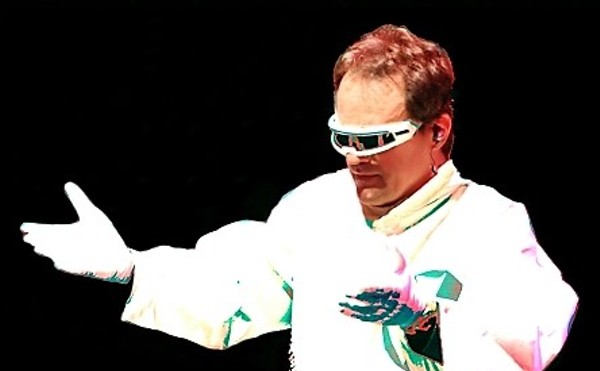New Book Provides Overview of Singer-Songwriter John Prine's Storied Career
In advance of upcoming Rock Hall appearance, author Holly Gleason discusses her new book
By Jeff Niesel on Fri, Dec 1, 2023 at 1:37 pm
[
{
"name": "Ad - NativeInline - Injected",
"component": "38482495",
"insertPoint": "3",
"requiredCountToDisplay": "5"
},{
"name": "Real 1 Player (r2) - Inline",
"component": "38482494",
"insertPoint": "2/3",
"requiredCountToDisplay": "9"
}
]
Award-winning writer and music scholar Holly Gleason just recently completed PRINE ON PRINE: Interviews & Encounters and has been touring the country to discuss the terrific collection of essays about the late singer-songwriter John Prine.
At 7 p.m. on Thursday, Dec. 7, Holly Gleason will appear at the Rock Hall with singer-songwriter Lyle Lovett and Fiona Whelan Prine to talk about the book.
In this recent email interview, Gleason talks about the process of assembling the tome, which she calls a labor of love.
You first met John Prine in 1985, something you describe in the book. Talk about what that initial meeting was like.
I’d gone backstage to apologize; I was mortified the Miami Herald had spiked my story [about Prine] for taking a job at the much smaller Palm Beach Post. I explained what happened, and John laughed. “Well then, [the interview] was like two friends talking — and not business.” Mind you, we’d spent two, two-and-a-half hours on the phone for the advance. Then, he proceeded to tell me about A Tribute to Steve Goodman, which got all the Chicago folkies plus Bonnie Raitt, the Nitty Gritty Dirt Band and Arlo Guthrie together to celebrate his best friend’s life. Stevie had died, and he was making sure he wasn’t forgotten. But again, it was all conversation set in caring, not pimping product. We sat there on a sofa outside the projector room at the Carefree Theater on Dixie Highway, a very ‘50s movie theater, just talking. Even though I’d been writing his lyrics in my school books since I was about 11, he just felt like a safe place and a favorite uncle. And I think that along the way, I’d mentioned I’d broken off my second engagement, so he was already plotting turning me into Dan Einstein’s girlfriend. His co-manager and the person who really built Oh Boy and Red Pajamas Records, Dan and I had had a disastrous first phone call, but when I said “Advance cassettes are really expensive, and that guy at your label doesn’t like me,” John said, “You let me handle it.”
...I had those two high density Maxell studio quality cassettes two days later.
By 1985, Prine was already an acclaimed (if under-appreciated) singer-songwriter. What it was like for you to track his musical career from that initial meeting up until his death in 2020.
I’m not sure it was tracking it as much as it was watching my friend do interesting things and thrive. When he made the two Howie Epstein-produced records (The Missing Years and Lost Dogs + Mixed Blessings), Bonnie Raitt had just had all that Nick of Time success — and he wanted to get in on proving that being over 40, writing smart songs from actual life, you could still make a mark. He had Tom Petty, obviously, Springsteen, David Lindley, Bonnie Raitt on there; VH-1 played the incredible Jim Shea-directed black and white video for “Picture Show,” and he finally won that first Grammy after being nominated almost 20 years earlier for Best New Artist.
In Spite of Ourselves was him having a ball after beating cancer singing old country songs with “girl singers.” The only original was the title track, which is also the theme from Billy Bob Thornton’s “Daddy + Them,” which he sang with Iris DeMent. How can you go wrong with a song that sings, ‘I caught him once, he was smelling my undies” and “She gets it on like the Easter bunny?” No wonder people get married to this song every week! And then in 2006, he comes back and wins his second Grammy for Fair + Square, which was a classic album of Prine songs. No tricks, no rock band. But his work was so good, and Oh Boy had really found its footing. I did the press for that record, and John worked really hard; but he also found a level of connection with the press where he was more than the perfect secret handshake or New Dylan. He was someone who was registering as an important American voice; while he hated talking about himself, he loved that people were seeing the songs. The pieces from this era really show that. And all of this was before the new Americana movement where he basically sailed into being the movement’s Willie Nelson!
As you started working on your book, how did you determine what articles you would include?
The assignment for the series, basically, is track the career of an artist in real time through the media and other places they can be documented. Dan Einstein and I remained close throughout his entire life — he passed away a year ago January — and he helped me cull, served as a backboard. His help was invaluable, because he’d remember key pieces or know who to go to for things. The Letter FROM the editor of HOT ROD magazine was something Dan remembered. When I couldn’t get the writer to sign the release, Dan made the call. George Dassinger, who’d been John’s publicist for the Missing Years and Lost Dogs, sent me all his files. People were really generous, because they knew I was trying to piece together so many things that aren’t easily accessible — and they wanted “their” John Prine remembered, because he turned into a pretty classic family guy in the last decades or so. The editor of Country Song Round-Up had to go into his storage unit, find the issue and send that to me. Robert Hilburn had to access his stories from the L.A. County Library because the L.A. Times morgue didn’t have it available. People didn’t even know they’d published the piece; they asked me for a copy! With the rush to digital morgues as the 20th century became the 21st, John Prine wasn’t important enough to log. Or things like Pulse, the Tower Records magazine, just went away. But documenting what it meant for a viable artist to walk away from major labels? That wasn’t done; it meant you were over. John had a definite sense of what he wanted his music to be, and he was certain if Steve Goodman could do it, so could he. It was so much work!
The book includes a great mix of material, from the Studs Terkel interview that focuses on Prine's working class background to that very eloquent piece by Jay Saporita that captures what it was like to sit on Prine's bus in 1975 between shows at the Bitter End. Do you have a favorite article?
I love that Jay Saporita piece because it’s that new journalism that Tom Wolfe and especially Joan Didion pioneered. He nailed it. And Robert Hilburn’s third piece, where John’s without a label and a little bit funny, very feral and even feisty makes me laugh. But of the written stuff, Ronni Lundy’s excerpts from Snap Beans, Stack Cake and Honest Fried Chicken: in part because I’d tried to get that pork roast recipe for years, but also because it really showed how much of a Southerner raised in the Midwest basic guy John was. His Mom’s hash... the tenderness they shared... and the notion of the pork roast that slow cooks all afternoon while you finish off the rest of the bottle of wine? That was John’s life, pre-Fiona, on the half shell! I loved John Mellencamp’s presentation of the PEN Lyrical Achievement Award. You get a sense of John Mellencamp as self-aware, a little contrite and so reverent. To see a massive rock and pop star own his space and exalt John? Tender isn’t a word people reach for with Mellencamp, nor vulnerable, but it was. That was the alchemy John conjured in people.
And Mike Leonard’s “Today” pieces kill me. To see how basic things were, to see John in a trinket store or Long John Silver’s laughing away, as well his own kitchen table and Cowboy Jack Clement’s studio. Those reported pieces on a music artist who would have had no shot at network television show his humanity in a very tactile way.
So many of the interviewers mention Prine’s Oh Boy label. Talk about its significance.
No one was doing it when they started out. Owning your own label meant you were over. One step away from K-Tel or Ronco, like Boxcar Willie or Zamfir. John didn’t care; didn’t quite know how it would turn out. But he was sure after leaving Elektra/Asylum, it couldn’t be any worse. “Sabu Visits the Twin Cities Alone” isn’t just an ironic song about a child star of a sagging movie franchise trying to flog the box office, it was an allegory. And when John struck out on his own, the fans stepped up. They were sending checks and money orders with notes that said, “Whenever the record’s done, send it to me.” He went into the studio with Jim Rooney, who also masterminded the Working in Corners box set of Nanci Griffith’s first albums that was just released, and created a sonic template that really suited his songs with Aimless Love. Not folk, not country, but true Prine. It worked Tammy Wynette cut “Unwed Fathers,” as cutting an indictment of young male sexual irresponsibility. Then, George Strait found his #1 “I Only Wanna Dance With You” on German Afternoons. Those kinds of recordings wouldn’t have worked as Madonna, Boy George and Michael Jackson dominated the mid- and late-80s!
I'm sure the label faced some challenges.
They had to build a distribution network piece-by-piece, convince rackjobbers – basically the middle men of smaller accounts back when — and larger chains to not just deal with a mom ’n’ pop label, but it was cash on delivery, because they couldn’t carry the debt. And they did it! I watched hand-over-hand Dan Einstein putting it together, John as proud as punch that he’d “beaten the system.” Then, they basically excavated the model, showed other people how to “do” a viable label on a national scale. There was no Go Fund Me, BandCamp, the Orchard for distribution, Amazon and Apple for sales, streaming or whatever. It was physical albums, cassettes, then CDs — which had to be made, sold, shipped, paid for and put in the stores, or mail ordered. They even had comment cards in the first few projects!
The book includes the last in-depth interview with Prine from 2020. That serves as such a great closing statement. Talk about what stands out to you from that interview that Bob Mehr did with Prine for the British music magazine Mojo.
How much his true self never wavered: he was always kind, aware, curious about humanity, staunch in his morality, sentimental about all the right things and a little saddened by the fact that the songs he wrote in the early '70s that were social commentary were as relevant now as they were when he wrote them. He’d believed they’d be outdated in a few years... and it amazed him that they were still pertinent.
And the fact that he was getting his flowers. He knew it, and it tickled him! He loves young artists, new songwriting voices... which is why Lyle [Lovett] is on this [Rock Hall] panel; that was not a new thing. So he was making music with interesting younger artists, Next Gen Americana-ians if you will, like Sturgill Simpson, Tyler Childers, Jason Isbell and Amanda Shires, his own Kelsey Waldon on Oh Boy, Margo Price and Kacey “Burn One With John Prine” Musgraves. He’d made arguably as strong an album as he’d ever made. The Tree of Forgiveness, written because Fiona sent him to the Omni Hotel and told him not to come home without enough songs for an album, more than measured up — and people were connecting with it. He was happy, but he also showed age doesn’t mean your talent’s diminished. He was in his glory... and he talked about taking a break after playing in Paris, which is sadly where the seeds of COVID were sown.
What will the upcoming Rock Hall event be like?
I’m not sure, honestly. We have two people who knew and loved John dearly. They both have such unique perspectives. Lyle [Lovett] and I were also both in Dublin on the trip where John met Fiona, and it was a magical time at the tapings for this series called “Sessions.” So many great roots artists — Guy Clark, Flace Jimenez, Jimmie Dale Gilmore, Marty Stuart, Joe Ely, Rosie Flores from America, Wilko Johnson and Mary Black, as well as Phillip Donnelly the band leader for over there — coming together to celebrate writing, playing and how much the Irish love great songs. We’d sit up all night, people would pass the guitar. Stories were told, songs debuted, Guinness drunk... and Dan, John and I went to Wind Mill Lane Studios, which U2 owned, for a tour set up by “Cowboy” Jack Clement, who helped inspire “Pride (In The Name of Love).” The beautiful dark haired woman who met us was Fiona — and I saw the smile on John’s face change. So, in the spirit of that sort of love and community, I think whatever happens is going to be wonderful and insightful.
Coming soon: Cleveland Scene Daily newsletter. We’ll send you a handful of interesting Cleveland stories every morning. Subscribe now to not miss a thing.
Follow us: Google News | NewsBreak | Instagram | Facebook | Twitter
At 7 p.m. on Thursday, Dec. 7, Holly Gleason will appear at the Rock Hall with singer-songwriter Lyle Lovett and Fiona Whelan Prine to talk about the book.
In this recent email interview, Gleason talks about the process of assembling the tome, which she calls a labor of love.
You first met John Prine in 1985, something you describe in the book. Talk about what that initial meeting was like.
I’d gone backstage to apologize; I was mortified the Miami Herald had spiked my story [about Prine] for taking a job at the much smaller Palm Beach Post. I explained what happened, and John laughed. “Well then, [the interview] was like two friends talking — and not business.” Mind you, we’d spent two, two-and-a-half hours on the phone for the advance. Then, he proceeded to tell me about A Tribute to Steve Goodman, which got all the Chicago folkies plus Bonnie Raitt, the Nitty Gritty Dirt Band and Arlo Guthrie together to celebrate his best friend’s life. Stevie had died, and he was making sure he wasn’t forgotten. But again, it was all conversation set in caring, not pimping product. We sat there on a sofa outside the projector room at the Carefree Theater on Dixie Highway, a very ‘50s movie theater, just talking. Even though I’d been writing his lyrics in my school books since I was about 11, he just felt like a safe place and a favorite uncle. And I think that along the way, I’d mentioned I’d broken off my second engagement, so he was already plotting turning me into Dan Einstein’s girlfriend. His co-manager and the person who really built Oh Boy and Red Pajamas Records, Dan and I had had a disastrous first phone call, but when I said “Advance cassettes are really expensive, and that guy at your label doesn’t like me,” John said, “You let me handle it.”
...I had those two high density Maxell studio quality cassettes two days later.
By 1985, Prine was already an acclaimed (if under-appreciated) singer-songwriter. What it was like for you to track his musical career from that initial meeting up until his death in 2020.
I’m not sure it was tracking it as much as it was watching my friend do interesting things and thrive. When he made the two Howie Epstein-produced records (The Missing Years and Lost Dogs + Mixed Blessings), Bonnie Raitt had just had all that Nick of Time success — and he wanted to get in on proving that being over 40, writing smart songs from actual life, you could still make a mark. He had Tom Petty, obviously, Springsteen, David Lindley, Bonnie Raitt on there; VH-1 played the incredible Jim Shea-directed black and white video for “Picture Show,” and he finally won that first Grammy after being nominated almost 20 years earlier for Best New Artist.
In Spite of Ourselves was him having a ball after beating cancer singing old country songs with “girl singers.” The only original was the title track, which is also the theme from Billy Bob Thornton’s “Daddy + Them,” which he sang with Iris DeMent. How can you go wrong with a song that sings, ‘I caught him once, he was smelling my undies” and “She gets it on like the Easter bunny?” No wonder people get married to this song every week! And then in 2006, he comes back and wins his second Grammy for Fair + Square, which was a classic album of Prine songs. No tricks, no rock band. But his work was so good, and Oh Boy had really found its footing. I did the press for that record, and John worked really hard; but he also found a level of connection with the press where he was more than the perfect secret handshake or New Dylan. He was someone who was registering as an important American voice; while he hated talking about himself, he loved that people were seeing the songs. The pieces from this era really show that. And all of this was before the new Americana movement where he basically sailed into being the movement’s Willie Nelson!
As you started working on your book, how did you determine what articles you would include?
The assignment for the series, basically, is track the career of an artist in real time through the media and other places they can be documented. Dan Einstein and I remained close throughout his entire life — he passed away a year ago January — and he helped me cull, served as a backboard. His help was invaluable, because he’d remember key pieces or know who to go to for things. The Letter FROM the editor of HOT ROD magazine was something Dan remembered. When I couldn’t get the writer to sign the release, Dan made the call. George Dassinger, who’d been John’s publicist for the Missing Years and Lost Dogs, sent me all his files. People were really generous, because they knew I was trying to piece together so many things that aren’t easily accessible — and they wanted “their” John Prine remembered, because he turned into a pretty classic family guy in the last decades or so. The editor of Country Song Round-Up had to go into his storage unit, find the issue and send that to me. Robert Hilburn had to access his stories from the L.A. County Library because the L.A. Times morgue didn’t have it available. People didn’t even know they’d published the piece; they asked me for a copy! With the rush to digital morgues as the 20th century became the 21st, John Prine wasn’t important enough to log. Or things like Pulse, the Tower Records magazine, just went away. But documenting what it meant for a viable artist to walk away from major labels? That wasn’t done; it meant you were over. John had a definite sense of what he wanted his music to be, and he was certain if Steve Goodman could do it, so could he. It was so much work!
The book includes a great mix of material, from the Studs Terkel interview that focuses on Prine's working class background to that very eloquent piece by Jay Saporita that captures what it was like to sit on Prine's bus in 1975 between shows at the Bitter End. Do you have a favorite article?
I love that Jay Saporita piece because it’s that new journalism that Tom Wolfe and especially Joan Didion pioneered. He nailed it. And Robert Hilburn’s third piece, where John’s without a label and a little bit funny, very feral and even feisty makes me laugh. But of the written stuff, Ronni Lundy’s excerpts from Snap Beans, Stack Cake and Honest Fried Chicken: in part because I’d tried to get that pork roast recipe for years, but also because it really showed how much of a Southerner raised in the Midwest basic guy John was. His Mom’s hash... the tenderness they shared... and the notion of the pork roast that slow cooks all afternoon while you finish off the rest of the bottle of wine? That was John’s life, pre-Fiona, on the half shell! I loved John Mellencamp’s presentation of the PEN Lyrical Achievement Award. You get a sense of John Mellencamp as self-aware, a little contrite and so reverent. To see a massive rock and pop star own his space and exalt John? Tender isn’t a word people reach for with Mellencamp, nor vulnerable, but it was. That was the alchemy John conjured in people.
And Mike Leonard’s “Today” pieces kill me. To see how basic things were, to see John in a trinket store or Long John Silver’s laughing away, as well his own kitchen table and Cowboy Jack Clement’s studio. Those reported pieces on a music artist who would have had no shot at network television show his humanity in a very tactile way.
So many of the interviewers mention Prine’s Oh Boy label. Talk about its significance.
No one was doing it when they started out. Owning your own label meant you were over. One step away from K-Tel or Ronco, like Boxcar Willie or Zamfir. John didn’t care; didn’t quite know how it would turn out. But he was sure after leaving Elektra/Asylum, it couldn’t be any worse. “Sabu Visits the Twin Cities Alone” isn’t just an ironic song about a child star of a sagging movie franchise trying to flog the box office, it was an allegory. And when John struck out on his own, the fans stepped up. They were sending checks and money orders with notes that said, “Whenever the record’s done, send it to me.” He went into the studio with Jim Rooney, who also masterminded the Working in Corners box set of Nanci Griffith’s first albums that was just released, and created a sonic template that really suited his songs with Aimless Love. Not folk, not country, but true Prine. It worked Tammy Wynette cut “Unwed Fathers,” as cutting an indictment of young male sexual irresponsibility. Then, George Strait found his #1 “I Only Wanna Dance With You” on German Afternoons. Those kinds of recordings wouldn’t have worked as Madonna, Boy George and Michael Jackson dominated the mid- and late-80s!
I'm sure the label faced some challenges.
They had to build a distribution network piece-by-piece, convince rackjobbers – basically the middle men of smaller accounts back when — and larger chains to not just deal with a mom ’n’ pop label, but it was cash on delivery, because they couldn’t carry the debt. And they did it! I watched hand-over-hand Dan Einstein putting it together, John as proud as punch that he’d “beaten the system.” Then, they basically excavated the model, showed other people how to “do” a viable label on a national scale. There was no Go Fund Me, BandCamp, the Orchard for distribution, Amazon and Apple for sales, streaming or whatever. It was physical albums, cassettes, then CDs — which had to be made, sold, shipped, paid for and put in the stores, or mail ordered. They even had comment cards in the first few projects!
The book includes the last in-depth interview with Prine from 2020. That serves as such a great closing statement. Talk about what stands out to you from that interview that Bob Mehr did with Prine for the British music magazine Mojo.
How much his true self never wavered: he was always kind, aware, curious about humanity, staunch in his morality, sentimental about all the right things and a little saddened by the fact that the songs he wrote in the early '70s that were social commentary were as relevant now as they were when he wrote them. He’d believed they’d be outdated in a few years... and it amazed him that they were still pertinent.
And the fact that he was getting his flowers. He knew it, and it tickled him! He loves young artists, new songwriting voices... which is why Lyle [Lovett] is on this [Rock Hall] panel; that was not a new thing. So he was making music with interesting younger artists, Next Gen Americana-ians if you will, like Sturgill Simpson, Tyler Childers, Jason Isbell and Amanda Shires, his own Kelsey Waldon on Oh Boy, Margo Price and Kacey “Burn One With John Prine” Musgraves. He’d made arguably as strong an album as he’d ever made. The Tree of Forgiveness, written because Fiona sent him to the Omni Hotel and told him not to come home without enough songs for an album, more than measured up — and people were connecting with it. He was happy, but he also showed age doesn’t mean your talent’s diminished. He was in his glory... and he talked about taking a break after playing in Paris, which is sadly where the seeds of COVID were sown.
What will the upcoming Rock Hall event be like?
I’m not sure, honestly. We have two people who knew and loved John dearly. They both have such unique perspectives. Lyle [Lovett] and I were also both in Dublin on the trip where John met Fiona, and it was a magical time at the tapings for this series called “Sessions.” So many great roots artists — Guy Clark, Flace Jimenez, Jimmie Dale Gilmore, Marty Stuart, Joe Ely, Rosie Flores from America, Wilko Johnson and Mary Black, as well as Phillip Donnelly the band leader for over there — coming together to celebrate writing, playing and how much the Irish love great songs. We’d sit up all night, people would pass the guitar. Stories were told, songs debuted, Guinness drunk... and Dan, John and I went to Wind Mill Lane Studios, which U2 owned, for a tour set up by “Cowboy” Jack Clement, who helped inspire “Pride (In The Name of Love).” The beautiful dark haired woman who met us was Fiona — and I saw the smile on John’s face change. So, in the spirit of that sort of love and community, I think whatever happens is going to be wonderful and insightful.
Coming soon: Cleveland Scene Daily newsletter. We’ll send you a handful of interesting Cleveland stories every morning. Subscribe now to not miss a thing.
Follow us: Google News | NewsBreak | Instagram | Facebook | Twitter
SCENE Supporters make it possible to tell the Cleveland stories you won’t find elsewhere.
Become a supporter today.
About The Author
Jeff Niesel
Jeff has been covering the Cleveland music scene for more than 20 years now. And on a regular basis, he tries to talk to whatever big acts are coming through town, too. If you're in a band that he needs to hear, email him at [email protected].
Scroll to read more Music News articles
Newsletters
Join Cleveland Scene Newsletters
Subscribe now to get the latest news delivered right to your inbox.

